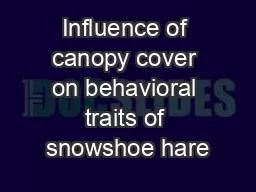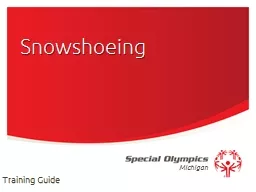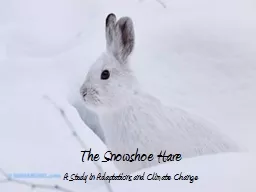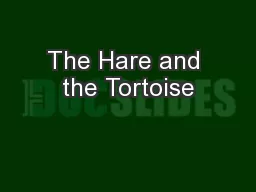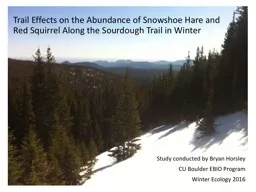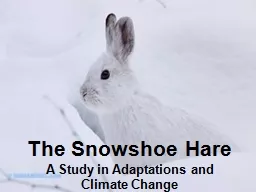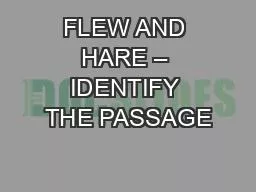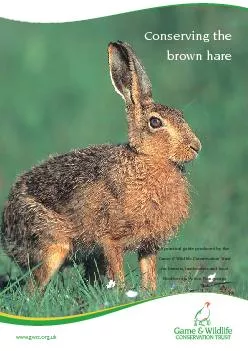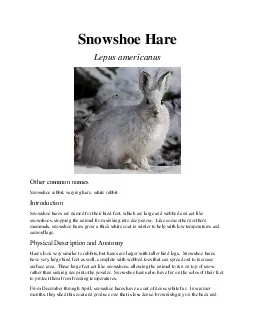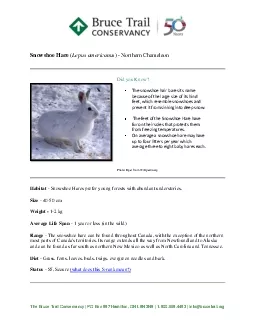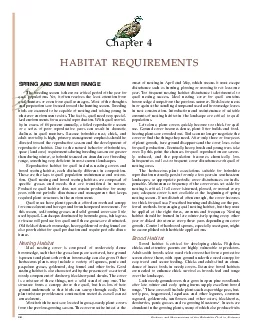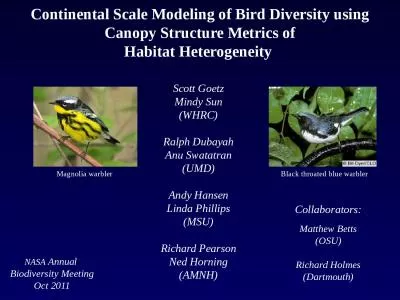PPT-Influence of canopy cover on behavioral traits of snowshoe hare
Author : basidell | Published Date : 2020-11-06
Breanna Avery Winter Ecology Spring 2018 Mountain Research Station University of Colorado Boulder Professor Tim Kittel Introduction The snowshoe hare Lepus americanus
Presentation Embed Code
Download Presentation
Download Presentation The PPT/PDF document "Influence of canopy cover on behavioral ..." is the property of its rightful owner. Permission is granted to download and print the materials on this website for personal, non-commercial use only, and to display it on your personal computer provided you do not modify the materials and that you retain all copyright notices contained in the materials. By downloading content from our website, you accept the terms of this agreement.
Influence of canopy cover on behavioral traits of snowshoe hare: Transcript
Breanna Avery Winter Ecology Spring 2018 Mountain Research Station University of Colorado Boulder Professor Tim Kittel Introduction The snowshoe hare Lepus americanus Mostly found in coniferous and boreal forests of the rocky mountains . Fanjingshan. National Nature Reserve:. “What measurable environmental changes have taken place after implementing payment for ecosystem programs?” . How reliably are we able to measure canopy fraction cover (CFC) and change in CFC (ΔCFC) within FNNR based on . Training Guide. 30 Meter. 50 Meter. 75 Meter. 100 Meter. 200 Meter. 400 Meter. 2. Special Olympics Michigan. Events Offered. Suggestions. It is suggested that beginner athletes enter the 30-meter and 50-meter events. Intermediate athletes should enter the 75-meter and 100-meter races. Advanced athletes should enter the 200-meter, or 400-meter events. . A Study in Adaptations and Climate Change. Snowshoe. Hares. Camouflage. Adaptations. . What do you know about:. The main habitat of the snowshoe hare is a taiga biome. . The taiga has warm, humid summers and freezing cold winters. . “I . am . the fastest . animal in the world. .”. said . a proud H. are.. But the . Tortoise . spoke . slowly. ,. “I . can beat you, should we race. ?”. Then. , the . race began.. At the . beginning. Squirrel Along . the Sourdough Trail in Winter. S. tudy conducted by Bryan Horsley. CU Boulder EBIO Program. Winter Ecology 2016. Research Question. Is there a negative “trail effect” on the abundance of snowshoe hares and/or red squirrels along the Sourdough trail in winter?. Head of Psychology & Interventions Head. . of Business Planning and Development. Probation Board for Northern Ireland Probation Board for Northern Ireland. The Future of Accreditation in Europe: . Buying a portable demo tent or shelter is definitely a wise investment you can make as a brand owner. Advertising your brand or business will become easier for you and your team as it is a great tool for promotional purposes. You can also use the product to provide shelter or shade whenever the need arises. Snowshoe. Hares. Camouflage. Adaptations. . What do you know about:. The main habitat of the snowshoe hare is a taiga biome. . The taiga has warm, humid summers and freezing cold winters. . The trees in the taiga biome provide an abundance of undergrowth covering the ground.. Make sure you say whether the passage is the ideas of . Mitchell or the ideas of Flew. . . Passage. Where. is it from?. What point is. it trying to make?. When the partisan asks for help and doesn't get it, what can he do? He can (a) conclude that the stranger is not on our side; or (b) maintain that he is on our side, but that he has reasons for withholding help. . Game & Wildlife Conservation Trust www.gwct.org.uk An animal of the open country The brown hare SourcesElbroch M 2003 MechanicsburgPA Stackpole BooksHoyt L 2016Mammals Dyken Pond Environmental Education Center Cropseyville NYOhio Department of Natural Resources ODNR ndMammals of Ohio Field guide 857 Hamilton ON L8N 3N9 18006654453 infobrucetrailorgSnowshoe Hare Lepus americanus-Northern ChameleonDid you KnowThe snowshoe hair bares its name because of the large size of its hind feet which re Ecology and Management of the Bobwhite Quail in Alabama17Ideal quail nesting cover is composed of moderately dense broomsedge such that the grass clumps are scattered bare ground is present and plants Habitat Heterogeneity. . Scott Goetz. Mindy Sun. (WHRC). Ralph Dubayah. Anu Swatatran. (UMD). Andy Hansen. Linda Phillips. (MSU). Richard Pearson. Ned Horning. (AMNH). NASA. Annual . Biodiversity Meeting.
Download Document
Here is the link to download the presentation.
"Influence of canopy cover on behavioral traits of snowshoe hare"The content belongs to its owner. You may download and print it for personal use, without modification, and keep all copyright notices. By downloading, you agree to these terms.
Related Documents

